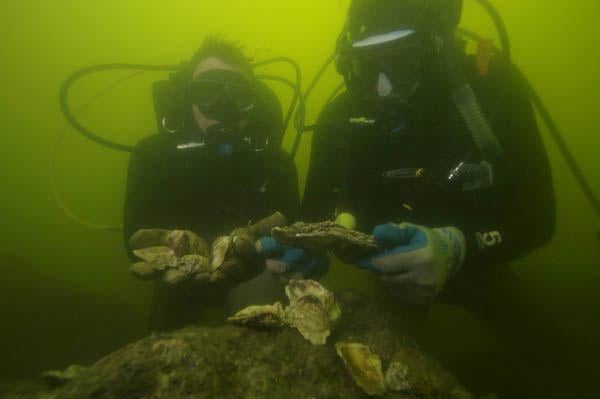Image above: Oysters are facing pressure from ocean acidification – the lower pH makes it harder for them to produce their shells. Photo: Michael Eversmier / MARI
By Arlo Hemphill
The State of Maryland has become one of the first states to take decisive action to address the impacts of ocean acidification. A newly released report issued by a State Task Force outlines the impacts that acidification has on Maryland waters and calls for monitoring, industry partnerships and collaboration with federal agencies to address the threat.
 Ocean acidification is a process in which atmospheric CO2 dissolves into the ocean and through chemical reactions lowers the pH of ocean water. Acidification can have grave consequences on plants and animals with shells made of calcium carbonate – which includes everything from clams to crabs, and the tiny phytoplankton at the base of ocean food chains. Increased acidity reduces the availability of carbonate ions that these organisms combine with calcium to form shells, exoskeletons, and skeletons. The ocean is estimated to absorb around 25% of the CO2 released annually into the atmosphere. As levels of atmospheric CO2 continue to increase, so do the potential impacts of acidification. The big picture impact may result in oceans depleted of such calcium-based organisms, in turn disrupting the entire marine food web.
Ocean acidification is a process in which atmospheric CO2 dissolves into the ocean and through chemical reactions lowers the pH of ocean water. Acidification can have grave consequences on plants and animals with shells made of calcium carbonate – which includes everything from clams to crabs, and the tiny phytoplankton at the base of ocean food chains. Increased acidity reduces the availability of carbonate ions that these organisms combine with calcium to form shells, exoskeletons, and skeletons. The ocean is estimated to absorb around 25% of the CO2 released annually into the atmosphere. As levels of atmospheric CO2 continue to increase, so do the potential impacts of acidification. The big picture impact may result in oceans depleted of such calcium-based organisms, in turn disrupting the entire marine food web.
The Maryland General Assembly formed the Task Force to Study the Impact of Ocean Acidification on State Waters during its 2014 session through House Bill 118. The bill states, “The Task Force shall: analyze the best available science regarding ocean acidification and the potential effects of acidification on the ecology of State waters and on State fisheries; and make recommendations regarding potential strategies to mitigate the effects of acidification on State waters and on State fisheries.”
The Task Force is comprised of representatives from the Maryland Senate, the Maryland House of Delegates, the National Aquarium, the aquaculture industry, the Maryland Watermen’s Association, the Maryland Departments of Natural Resources (DNR) and the Environment (MDE), the University of Maryland Center for Environmental Science (UMCES), the Chesapeake Bay Foundation, and several outside experts. Members have been meeting monthly since July 2014 to review the science and basic problems caused by acidification in Maryland waters. Although much is now known about the role of acidification in the open ocean, very little was previously known about complex acidification processes in shallow estuarine environments such Maryland’s Chesapeake and Coastal Bays. These coastal systems are highly sensitive to terrestrial inputs, and potential impacts may be posed to aquaculture and important fisheries such as oysters, crabs and striped bass.
Maryland’s Task Force focused on seven key areas that would improve our understanding of acidification, leverage research being done across the nation, and identify specific impacts on Maryland industries and economy. These areas include:
- Enhancing monitoring of State waters to quantify scale, patterns and trends of ocean acidification
- Establishing additional research priorities in estuarine and coastal waters
- Improving coordination with other state and federal resource managers
- Focusing on impacts to key species and associated activities, such as blue crabs, oysters and striped bass
- Providing direct support to affected industries
- Pursuing legislative action
- Improving communications and outreach
Taken as a whole, the seven issue areas will put Maryland in an advantageous position towards understanding, communicating and mitigating the impacts of rising CO2 emissions on state waters.
Ocean acidification is a globally documented concern affecting oceans and estuarine ecosystems alike. The Mid-Atlantic, home to several of the nation’s largest bays and estuaries, offers an excellent example as to how these ecosystems are intimately linked. Billions of gallons of water are exchanged each day on and offshore through tidal movements at the mouths of our major estuaries, while economically important species – and the human activities that depend on them – migrate on and offshore throughout various stages of their lifecycles. The Maryland Task Force built upon years of research and concern generated over the recovery of the Chesapeake to produce a groundbreaking analysis on the impacts of ocean acidification on state waters. However, their findings are relevant to Maryland’s offshore waters and the Mid-Atlantic ocean region.

